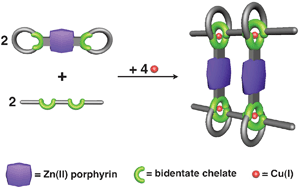The origins of abiotic species
How can life originate from a lifeless chemical soup? This question has puzzled scientists since Darwin's 'Origin of species'. University of Groningen chemistry professor Sijbren Otto studies 'chemical evolution' to see if self-organization and autocatalysis will provide the answer. His research group previously developed self-replicating molecules and have now observed diversification in replicator mutants. They found that if you start with one ancestral set of replicator mutants, a second set will branch off spontaneously. This means that ecological diversity as encountered in biology may well have its roots at the molecular level.
It is impossible to know how life on Earth really started, but that doesn't stop scientists from trying to find out how it could have started. This is not just a matter of curiosity. The processes involved include autocatalysis (where molecules promote the formation of copies of themselves) and self-organization (where molecules spontaneously organize themselves into higher-order structures) which are important concepts in such fields as materials science.
Replicators
Otto has been working on chemical evolution for several years now. 'It started with a chance discovery', he explains. 'We found some small peptides that could arrange themselves into rings, which could then form stacks.' Once a stack began to form, it would continue to grow and would then multiply by breaking into two smaller stacks. These would both grow and break again, and so on. The stacks also stimulated the formation of the rings from which they are composed. The stacks and rings are called 'replicators', as they are able to make copies of themselves.
Jan Sadownik, a postdoc in the Otto group, discovered that if you offer the replicators two different types (A and B) of building blocks ('food') they will make copies of themselves. He observed the emergence of a set of replicator mutants that specialized in food A, but also incorporated some B. The rings mainly comprised the A building blocks, with just a few B's.
Some days later Sadownik saw a second set of mutants emerge that specialized in food B, but also tolerated some A. This second set proved to be a descendant of the first set, which meant there was an ancestral relationship between the sets. This is very similar to how new species form from existing ones during biological evolution, except that this process of species formation does not involve full-fledged biological organisms, but occurs instead at the molecular level.
Molecular speciation
Looking at the molecular 'speciation' process in more detail allowed the researchers to identify specific mutants within the first set of replicators that were responsible for the generation of the second set. They had therefore established the mechanism by which replicator 'species' form with unprecedented molecular-level detail. The spontaneous diversification of replicating molecules into distinct sets may well have been the first step in a long process that has led to the stunning ecological diversity that we see all around us today.
This shows how new 'species' can emerge through chemical evolution. Otto explains, 'Of course, the term speciation should only be used when referring to sexually reproducing organisms, but our work shows much the same patterns.' The exciting part, says Otto, is that 'we start with no replicators, but see first one type emerge and then after a while, another. That is certainly most significant!'
The next step is to introduce death. This can be done by feeding the system a constant flow of building blocks, while draining the contents of the reaction vessel. Replicators can only survive in this system when their growth rate exceeds the removal rate. 'We could then seed such a system with one set of replicator mutants, and then change the environment, for example by adding another solvent. This would change the fitness of the various replicator mutants and shift the population of mutants towards those that are best at replicating in the new environment.' The result would be a form of natural selection that Darwin would recognize. 'We're not the only ones to be really excited about these experiments - the evolutionary biologist I've consulted is too.'
Original publication
Other news from the department science

Get the chemical industry in your inbox
By submitting this form you agree that LUMITOS AG will send you the newsletter(s) selected above by email. Your data will not be passed on to third parties. Your data will be stored and processed in accordance with our data protection regulations. LUMITOS may contact you by email for the purpose of advertising or market and opinion surveys. You can revoke your consent at any time without giving reasons to LUMITOS AG, Ernst-Augustin-Str. 2, 12489 Berlin, Germany or by e-mail at revoke@lumitos.com with effect for the future. In addition, each email contains a link to unsubscribe from the corresponding newsletter.

























































